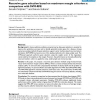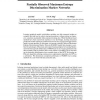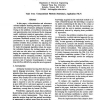37 search results - page 3 / 8 » A maximum margin discriminative learning algorithm for tempo... |
BMCBI
2006
13 years 7 months ago
2006
Background: In class prediction problems using microarray data, gene selection is essential to improve the prediction accuracy and to identify potential marker genes for a disease...
ICPR
2008
IEEE
14 years 1 months ago
2008
IEEE
In this paper, a novel subspace learning method, semi-supervised marginal discriminant analysis (SMDA), is proposed for classification. SMDA aims at maintaining the intrinsic neig...
NIPS
2008
13 years 9 months ago
2008
Learning graphical models with hidden variables can offer semantic insights to complex data and lead to salient structured predictors without relying on expensive, sometime unatta...
ICCV
2009
IEEE
15 years 14 days ago
2009
IEEE
Visual categorization problems, such as object classification or action recognition,
are increasingly often approached using a detection strategy: a classifier function
is first ...
COLING
1992
13 years 8 months ago
1992
In this paper, a discrimination and robusmess oriented adaptive learning procedure is proposed to deal with the task of syntactic ambiguity resolution. Owing to the problem of ins...



